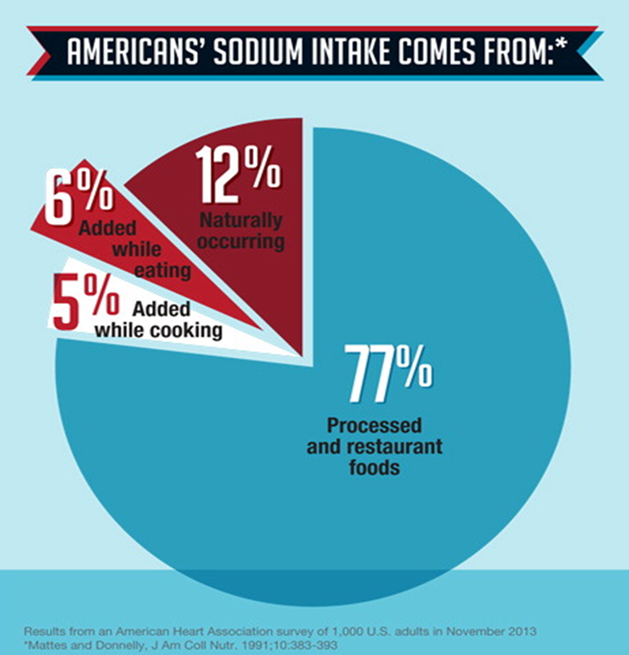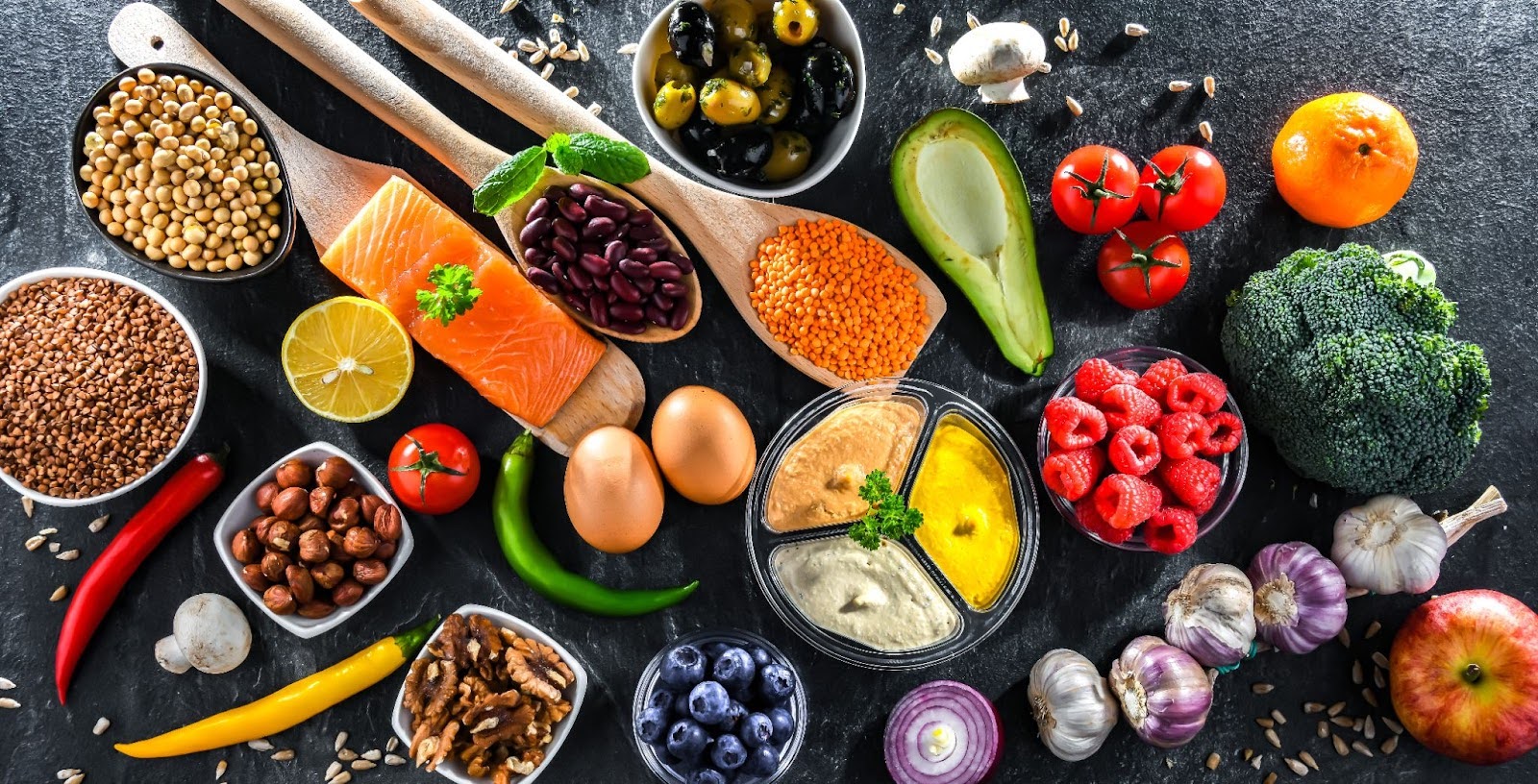 Hi Fit Fam!
Hi Fit Fam!
The statistics for sodium intake in the United States are sobering. Americans generally eat more than 3,400 mg of sodium each day; significantly above the 2,300 mg recommendation set forth by the 2010 Dietary Guidelines. 97% of us do not know or underestimate our sodium intake. Can you quickly answer the average sodium milligrams you ingest? If not… start counting.
When trying to reduce sodium intake, we often start with the salt shaker on the table. While this could be of benefit for some, the graphic below shows us that the majority of our sodium intake comes from packaged, processed, store-bought, and restaurant foods. Only a small amount comes from salt added during cooking and at the table. So if you say to me “I don’t ever add salt to my food” it’s still a very small piece of the pie folks. You got to look at the nutrient label and count those milligrams.

Most of us can take steps to decrease sodium intake through processed foods. What does it mean for a food to be “processed”? At the end of the day, all food exists on a spectrum of processing. Let’s take a looksy: Completely unprocessed foods are foods we eat that are exactly how it existed in nature, like bananas and zucchini. Moderately processed foods are often healthy when the right choice is made, like with jarred pasta sauce, canned beans, and yogurt. Completely processed foods are those in which nothing that goes into it is in its natural state, like chicken nuggets. Much of what we eat lies somewhere between those extremes. A diet that contains some low to moderately processed foods can still support good health, but the more heavily weighted toward the processed side a diet is, the less healthy we are likely to be, and all of these markers increase heart health risks. Learn more with the Salty Six.
Just a DASH: Increasing Potassium, Calcium, & Magnesium
We often think about reducing sodium and unhealthy fats for overall health, but what about potassium, calcium, and magnesium? The DASH (Dietary Approaches for Stopping Hypertension) Diet is aimed to be a lifelong approach to healthy eating, designed to help treat or prevent hypertension (high blood pressure). You know I’m opposed to “diets” but this one is all about ADDING nutrient dense foods that lower blood pressure and not about deprivation cause you know that’s a downward spiral to misery. The DASH Diet focuses on nutrients that help blood pressure, such as potassium, calcium, and magnesium. Researchers believe that it is the combination of 8 to 10 servings a day of fruits and vegetables, and 3 servings of low-fat or nonfat dairy products that causes the DASH eating plan to lower blood pressure. I hate that it’s called a diet but it is a legit way to eat.
Simply taking calcium, potassium, and magnesium supplements does not lower blood pressure. Sorry guys.
Salt Sensitivity & Fluid Balance
Salt sensitivity is a measure of how a person’s blood pressure responds to salt intake. While there is disagreement on the exact definition and cause, those who are sensitive to salt are more likely to have high blood pressure. Unfortunately, there is no clear test for measuring salt sensitivity. People of Asian or African ancestry, older age, female, or those that have high blood pressure or kidney disease are all associated with salt-sensitivity. Being overweight can also increase risk for salt sensitivity. So how does this work?
Excess salt consumption leads to the body retaining water. Blood volume increases, which causes the heart to work harder, increasing blood pressure, thereby damaging blood vessels.
Choosing Salt: Are popular varieties better for me?
There is really no chemical or nutritional difference between regular table salt, sea salt, and kosher salt. Sea salt can be processed in a way that produces larger crystals that, when sprinkled on a dish, give a concentrated burst of saltiness and an additional crunchiness. The size and shape of the kosher salt crystal is larger and flatter, as if you took a medium-coarse grain of salt and put it through a roller. Because of the increased surface area of kosher salt crystals, they dissolve more readily on your tongue. Other trace minerals not filtered out of sea water in some regions can produce fancy pink, gray, green, and lavender gourmet salts. Because they are not as pure, these gourmet salts are sometimes a bit lower in sodium than regular table salt, however the trace minerals are found in such small quantities that meaningful nutritional benefit is unlikely. Bottom Line: We get too much sodium in our everyday – switching to a new variety is not likely to make a significant difference in our sodium intake. Limit processed food: Aim to eat the least processed and freshest food possible most of the time.
When You’ve Overdone the Salt
Although it may seem counterintuitive to drink water when your body is already full of the stuff, it’s actually necessary. Water is a diuretic, so it triggers your body to remove excess water and flush sodium from your digestive system. After eating too much salt, your body holds onto water because it’s trying to prevent dehydration. Drinking water is a gentle reminder to your system that you’re well-hydrated without the extra water retention. Although water should be your main drink of choice, ginger, chamomile and peppermint tea can also help you de-bloat. These types of teas not only act as diuretics but also calm your digestive system. If you just can’t imagine guzzling another ounce of water, turn to water-rich fruits instead. Watermelon, cantaloupe, honeydew, oranges, pineapple, grapefruit, celery and cucumbers are all effective choices when trying to de-bloat. If you need to eat on the run, toss these water-rich fruits into a blender with a bit of yogurt (also high in water) and a few ice cubes for a tasty, de-bloating smoothie.
The American Heart Association explains that potassium is a powerful ally in your fight against sodium retention. Potassium plays a double duty in the body, not only encouraging sodium excretion but also relaxing blood vessel walls and lowering blood pressure. Potassium-rich foods include bananas, sweet potatoes, tomatoes, oranges, melons, apricots, raisins and yogurt. The association recommends a daily potassium intake of about 4,700 milligrams for the average adult.
Getting at least 30 minutes of exercise can help relieve bloating symptoms by keeping fluids moving through your system. Go take a Studio Sweat class! Staying active can also push gas through your digestive tract, a common culprit of tummy discomfort.
Homework! Find out how much sodium you are getting with this Sodium Tracker.
Toodles!
Miriam Jirari
Studio SWEAT Dietitian
Sources: WebMD, Harvard University; Psychology of Eating, www.Livestrong.com









Comments - 0